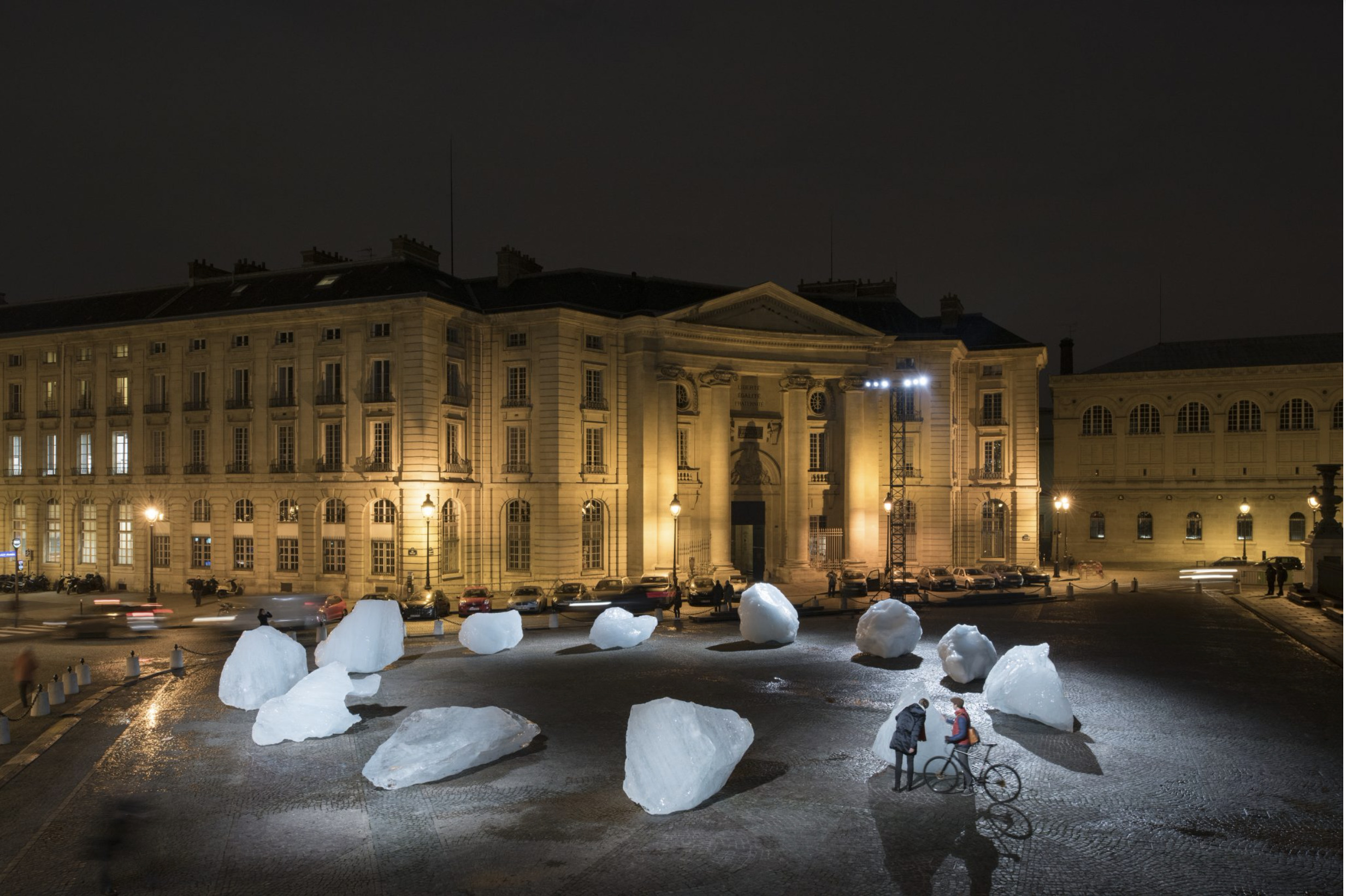* How should the art world react to companies that sponsor the arts while damaging the environment?
* Is it ethical for such companies to sponsor art?
* Will the art world ignore this contradiction, or will it bring it to light?
* Does sponsoring artistic events erase these companies’ environmental destruction record?
* Shouldn’t arts institutions that receive sponsorship from these companies also bear some responsibility?
* Will the art world continue to trust these institutions?
Unfortunately, some commercial companies are contributing to environmental destruction. Their actions lead to high levels of greenhouse gas emissions, air pollution, and the loss of forest land. These activities endanger various living species and negatively impact ecosystems. Burning fossil fuels accounts for about two-thirds of all greenhouse gas emissions.
These emissions are causing climate change, which is already devastatingly impacting the planet. Climate change is melting glaciers and raising sea levels, impairing agricultural yields, and increasing the spread of diseases. Another major problem caused by large companies is deforestation. Deforestation causes species extinction by destroying the habitats of plants and animals. These companies release pollutants into the air, water, and soil, causing health problems for humans and animals and damaging ecosystems. For example, oil spills caused by BP and Exxon Valdez have recently been shown to have a devastating effect on marine life. Of course, these international companies are just a few that caused the destruction. Looking at the NRDC’s “Toxic 100: The World’s Worst Corporate Polluters” report, one can see the top 100 most polluting companies. In addition, the RAN’s “Banking on Destruction: How Banks Finance Deforestation” report also highlights how significant banks around the world finance deforestation projects.
This article does not cover international environmental issues and their causes, as it is beyond my expertise. Instead, I will discuss the contradiction behind the support of companies and artistic projects that I find interesting. It’s important to note that companies causing environmental destruction is just one aspect of the issue. On the other hand, there is a phenomenon called “art washing,” where companies do the opposite of what they claim to do. It’s a way for companies to hide their harmful activities through sponsorships, as noted by Osman Erden in his article “The crisis created by İKSV, the harmlessness of art, the laundering with art” on politicalyol.com. This paradox has been a topic in contemporary art for a long time. It’s confusing how commercial companies sponsor exhibitions promoting ecology while pursuing projects harming the environment. It’s a contradiction that delivers two opposing messages. They support environmentalism and sustainability by sponsoring related exhibitions and events, indicating their concern for the environment and desire to protect it. However, their actions that harm the environment demonstrate a lack of genuine commitment to environmentalism, and their use of art to improve their public image further highlights this disconnect.
There is a clear contradiction when it comes to companies sponsoring ecology-based exhibitions. Such exhibitions usually highlight the significance of nature conservation and the importance of sustainability. However, it’s often the same companies that support these events that are responsible for environmental destruction. This behaviour is hypocritical and raises doubts about the sincerity of these companies towards the ecological cause.
The sponsorship of art by companies that harm the environment is called “green washing”. On the other hand, Green laundering is when a company tries to portray itself as environmentally friendly to improve its public image, but in reality, its activities are harmful to the environment.
Certain companies sponsor artistic projects related to environmentalism to appear committed to sustainability. However, their actions suggest otherwise. Supporting art while being harmful to the environment is a serious problem that the art world is aware of. Companies engaging in green laundering are periodically exposed to this contradiction.
In recent times, numerous organizations have sponsored contemporary and modern art museums or exhibitions. However, some critics believe that this trend puts pressure on the exhibitions to promote a positive corporate image, which in turn leads to a decline in the quality of the artwork displayed. Mobil Oil sponsored several events in Cameroon, Nigeria, and New Zealand during the 1980s to improve its reputation in those countries. While some critics perceive this as a dishonest tactic, others argue that sponsorships do not affect the content of the exhibitions. In Turkey, on the other hand, many writers and artists have expressed similar views, stating that festivals can be enjoyed without paying attention to the sponsors’ logos.
Hyundai, a sponsor of exhibitions at prestigious venues such as the Tate Modern, the Los Angeles Museum of Art (LACMA), and the National Museum of Modern and Contemporary Art in Seoul, has faced criticism. Though the company’s support of cultural events has been praised for promoting Korean culture and art, some have raised concerns about its environmental impact. Hyundai was ranked as the most polluting company in the world in the Carbon Disclosure Project of 2015. The question remains: How is the situation Turkey evolving when it comes to environmentalist actions and art washing?
The answer is simple: “Not different at all!” Koç Holding is involved in projects that harm the environment, including mining and oil drilling. This makes them a prime example of companies that prioritize profit over sustainability. Despite this, they support artistic projects like the Istanbul Biennial. It’s a well-known fact that Koç Holding uses art to improve its image and divert attention from its environmental record. Sabancı Holding is another Turkish company that engages in damaging projects such as construction and coal mining. They also support the Sakıp Sabancı Museum and other artistic activities.
The recent focus in Turkey has been on the situation in the Akbelen Forest. This forest is located in the İkizköy area of Muğla’s Milas district and spans over 1,200 hectares. It’s home to various types of trees, such as pine, oak, alder, and chestnut, as well as a range of animals including bears, deer, wild boars, foxes, and rabbits. Unfortunately, since 2021, the forest has been under threat due to plans to open a coal mine. If the mine is fully operational, approximately 400 hectares of the forest and thousands of trees could be lost. Moreover, the coal mine could potentially alter the region’s climate and destroy habitats for the forest’s animal species.,
The proposed coal mine project in İkizköy received a strong response from the local community. Residents of the village expressed their worries regarding the potential environmental and social consequences of the project, and took action by organizing petitions and demonstrations in an effort to halt the project. The local community, environmental NGOs, and activists are actively protesting against Limak Holding’s plan to open a coal mine in the Akbelen Forest due to their concern for the environment. In contrast, Limak Holding argues that their project will not cause any harm to the environment or human health and emphasizes the potential benefits to the economy and job creation. It is our greatest desire that the environmental struggle ends successfully. But, what insights can we gain from the profile of Ebru Özdemir, the Chairperson of Limak Holding’s Board?
Can we separate Özdemir, a supporter of artistic projects and member of the SAHA group, from the issue of art laundering that we previously discussed? Absolutely not. Furthermore, a contradiction reported in the media has left many people astonished. Ebru Özdemir, Chairwoman of Limak Holding’s Board of Directors, is also a member of the Board of Trustees for WWF Turkey’s branch. This is quite ironic since Özdemir’s company and YK Energy, a joint affiliate of IC Holding, have been cutting down trees in order to expand their mining area. Despite being environmentally friendly and supportive of artistic projects, local citizens who wish to prevent this tree massacre are being attacked by law enforcement.
There are several companies in Turkey, such as Koç, Sabancı, and Limak, which support the arts, but at the same time, they are involved in projects that harm the environment. Many other companies in the country also fall under this category. The art world faces a crucial issue: how should it react to these companies that sponsor the arts while damaging the environment? Is it ethical for such companies to sponsor art? Will the art world ignore this contradiction, or will it bring it to light? Does sponsoring artistic events erase these companies’ environmental destruction record? On the other hand, shouldn’t arts institutions that receive sponsorship from these companies also bear some responsibility? Can they claim ignorance about who is on their board of trustees or whom they support through their projects? Obviously, this cannot be acceptable. Will the art world continue to trust these institutions? These are important questions that need to be addressed.
It’s evident that answering these questions isn’t straightforward, as they’re complex. Nonetheless, it’s crucial for the art community to know which environmentally harmful corporations support cultural and artistic initiatives, and the potential issues they may cause.
The topic of corporate art sponsorship is multifaceted and does not have a simple solution. While it can offer crucial financial backing for museums and exhibitions, it can also create conflicts of interest and showcase art that may not be of the highest caliber. It is vital to acknowledge the potential drawbacks of corporate sponsorship in the arts and to scrutinize company-sponsored exhibitions with a critical eye. When perusing an exhibition, a thoughtful and observant viewer should take note of any sponsor logos, or perhaps consider the lessons learned from the Gezi Park Resistance.











